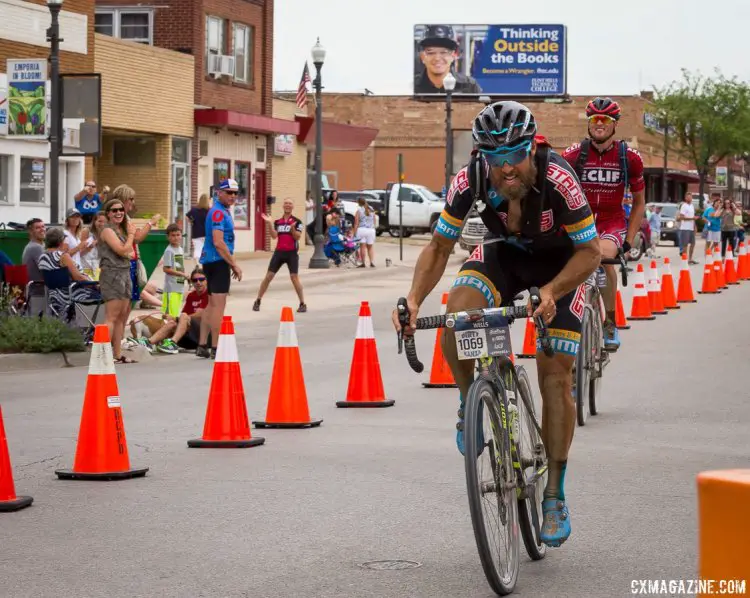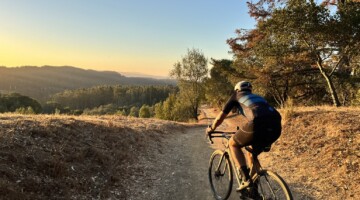Update: Listen to full audio of my conversation with Jake
Jake Wells is no stranger to epic mountain bike races, and this year he decided to try his hand at arguably the granddaddy of epic events, the Dirty Kanza 200.
In an interview with Cyclocross Magazine, Wells said his approach to racing the event changed once he decided to do it. First, he was just going to do the DK100, and then once he signed up to race the 200-mile event, he said he was just hoping to make the lead selection at the last aid station.
It turns out, Wells far exceeded his expectations in the Dirty Kanza 200 by making the ultimate selection with Mat Stephens and Menso de Jong and then nipping De Jong down the finishing straight to take 2nd place in his first Dirty Kanza 200.
In our conversation, Jake Wells provided in-depth insight on what it’s like to train and race for events like the DK200 and what equipment choices he had to make before race day. Read on for some excerpts from our conversation and stay tuned to Cyclocross Magazine for full audio from our interview.
Jake Wells DK200 Interview Excerpts
Cyclocross Magazine: How did you decide you wanted to race the Dirty Kanza?
Jake Wells I coach a couple different athletes who expressed interest in doing the race this year. It ended up one only one guy who I coach decided to do it. There was a group of five of us from my area, Eagle County area, who all decided they’d all go out and do it. Four of us did the 200 and one of the females did the 100. So when my client Adam decided that he was going to do it, I thought Yeah, I’ll go. Maybe I’ll just do the 100. When it was getting close to time to sign up, I was like I think if I go out and just do the 100, I am just kind of going to be unfulfilled.’\ And so I’ll end up wanting to go back and do the 200 anyway, so I was like ‘Well, might as well jump in with both feet,’ and I signed up for the 200. I was kind of looking for that kind of event. That really put me out of my comfort zone.
CXM: What were your expectations for the event?
JW: I really didn’t know what to expect. I was doing as much research as I could in terms of, you know, years past. As far as bike selection, bike setup, and conditions. But there’s so many unknowns, my goal going into the race was if I could get to that third aid station with the lead group, then it would be a success for me. And then I would kind of see how it panned out after that.
CXM: Since you do some coaching, what advice would you give to cyclocross racers who want to do an epic gravel event like the Dirty Kanza?
JW: I think the main thing is just do your homework. I feel like you’ve got to talk to a few people who have done the event. After I signed up, a buddy of mine who lives outside of Kansas City and manages a club level team in that area, I was chatting with him about what to expect, and he was invaluable, not necessarily in terms of what to expect with terrain, but that event is really unique because it’s self-supported. So, you know, what to prepare for in terms of aid stations, what to do with your Garmin and turn-by-turn navigation and those kinds of things. I think going into that event I was prepared fitness-wise, but more than anything I was prepared for pretty much anything that the course and conditions were going to throw at me. I think that’s probably the main thing.
And what I see a lot with athletes I work with is limitations they have with life in terms of just getting out to get hours in on the bike. So it can be a really challenging thing to prepare for a century ride much less a 200-mile ride where you’re going to be on the bike for 12+ hours. Managing your time and getting the most bang for your buck in preparing for an event like that. Luckily where I am you have big mountain passes and climbs that you can do where you don’t have those kinds of demands in the actual event, but you are on gravel and the rolling resistance is higher, the draft effect is less. Doing tempo and aerobic threshold Zone 2 stuff on these climbs really helps a lot as well.
I think those are the main things. Do your homework. See what the demands of the event are going to be. Try to be as prepared as you can, even if you don’t have big sections of dirt or gravel road to go ride. At least you can prepare as much as possible in terms of equipment and course conditions. Prepare for the demands of the event. You can break it down and be like ‘My goal is X,’ if your goal is to finish before sunset or before midnight, whatever your goal is, you gotta look at the demands of that. What is the average speed at that pace?
One of the biggest things people overlook is the caloric intake that is demanded by your body for that amount of time. If you’re riding at a decent tempo, you’re going to be burning 500-700 calories an hour, so it won’t be long until you’re at a deficit. So getting your nutrition dialed and your eating program, when to eat on the bike.
“Do your homework. See what the demands of the event are going to be. Try to be as prepared as you can.”
CXM: If I did the Dirty Kanza, I would just hope to survive and finish. What is it like at the front racing to win?
JW: At the front, and that’s what’s really interesting about these types of events. You stage based on, it’s the honor system, but you’re staging based on estimated finish time. They have a 12-hour corral and then a 14-hour corral, and a 16-hour and so on. And it’s just up to you to stage yourself into the corral that you feel like you belong in. Once we get ready to go and take off and start, you’re behind a couple cop cars and it’s neutral roll-out for the first two miles on pavement and then you make a hard right onto the dirt and you’re off and racing. Those kinds of starts are always a little bit hectic. People are jockeying for position. They want to be up toward the front so they don’t get gapped whenever selections are starting to be made. And there’s really only two lines because you’re riding where the vehicle tires are going and those are the hard-packed lines and everything else is loose gravel. It makes it more challenging to stay in the group and your risk of puncturing early on in the race is higher too.
The first hour is a little bit unnerving. I’ve done a lot of road racing, I’ve done a lot of ‘cross racing, and raced my mountain bike a lot as well, so I am really comfortable riding in a group and riding on mixed surfaces at speed. But you never know what the ability of the guys around you is going to be. When you’re in a Pro/1/2 crit, you know everyone can handle the bike pretty well. If you bump against somebody, they’re probably going to be fine, they’re not going to grab the brakes or freak out. But in this kind of event you don’t know what they level of the riders around you are. Maybe they’re a mountain biker and they ride by themselves and they never ride in a group.

Jake Wells sprinted past Menso de Jong on the finishing straight to get second at the 2017 Dirty Kanza gravel race. © Christopher Nichols
CXM: You had an exciting finish to get second. How did that play out?
JW: I would kind of see Menso [de Jong] make a right turn and I would count the seconds. It was 30 seconds and then 20 seconds. By that point, we were getting onto the pavement. You come off the gravel for the last time and you go through this little tunnel and you pop out onto the campus of Emporia State University. I had ridden that section the day before, so I knew kind of what the last 10 looked like, so I know what was left. My Garmin was telling me there’s like 6/10 of a mile left in the race and there’s one steep paved climb you have to go up. That seemed to be, on the flats I wasn’t riding away from anyway, wasn’t riding away from Mat or Menso, but I felt like on the steeper climbs that was kind of the equalizer for me. I was able to put down a little more power and make up some time, or put in a little bit of time on those guys on the steeper stuff.
That short steep climb at the end I could tell I was getting pretty close to catching Menso. Once you go over the top of that, you really have just a short downhill, a couple chicane turns, and then you go through this little park area, and then you’re onto the finish straight. At that point I was not really confident I was going to catch him. I wasn’t really expecting to catch him on the finish straight. I thought he had something left in the tank. But then we get onto the finish straight and it’s all coned off, and you can see the finish, but it’s a long way. It’s probably seven blocks from where you get onto the main strip and the finish. I could see Menso wasn’t that far ahead of me and he’s kind of slowing down. I was reeling him in slowly without really meaning to, without putting in a hard sprint effort. It got to the point where I was like ‘I can’t not sprint. I can’t not try to catch him.’ He was so close that I couldn’t not try to put in an effort.
“It got to the point where I was like ‘I can’t not sprint. I can’t not try to catch him.’ He was so close that I couldn’t not try to put in an effort.”
The crowd was just going crazy. Not necessarily because they saw this potential sprint finishing coming. More, I think they were just excited and were welcoming us back to town. Menso was embracing that and kind of taking it in. I put in a hard effort and stood up and drilled it past him with probably 100 meters left in the race and got around him. I talked to him after and was kind of apologetic and said ‘I hate to sprint you at the finish like that,’ and he said, ‘I had nothing. I couldn’t turn another pedal stroke.’ I think he was psyched to finished third, and I was psyched to get second. It’s crazy to think that after hour 10 hours and 50 minutes of racing it comes down to 1 second between 2nd and 3rd.
Wells provided this look at his bike and equipment for the DK200.
Update: Listen to full audio of my conversation with Jake
In the meantime, check out this great photo essay from the Dirty Kanza 200 by Christopher Nichols if you have not already seen it.




























